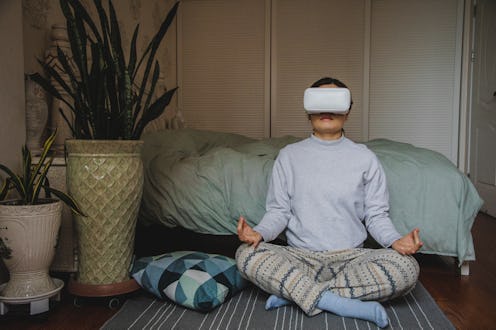Tech
How VR Meditation Helped Me *Actually* Shut Out Distractions
Achieving calm in the metaverse.

Floating weightlessly miles above the Earth, I look down to see pink cotton candy clouds beneath me. A soft voice suggests that I watch a flock of birds soar through the air, focusing my attention on their movements. It might sound like I’m dreaming, but the serene scene in front of me is powered by Liminal, a wellness platform available on the Oculus Quest 2 headset. I’m actually deep in a virtual reality meditation session.
Virtual reality, once the domain of science fiction novels and university labs, is on the brink of going mainstream. With Facebook’s recent rebrand to Meta and CEO Mark Zuckerberg’s $10 billion investment into virtual and augmented reality last year, experts believe that the metaverse is going to occupy an increasing proportion of our work and social lives over the next few years. Researchers are already exploring how the metaverse could provide benefits on a deeper level: Recent studies have shown that virtual meditation could help people in substance use recovery or aid in preparing patients for surgery.
It’s well-known that regular meditation can help to reduce stress and anxiety, but in my experience, it’s been the opposite. Every few months, I give classic meditation a try, but my sessions usually go the same way: I find a comfortable spot and breathe deeply, trying to expel both positive and negative thoughts from my mind with each exhale. Except, my stressors often take the opportunity to fill the empty space. Do I call my parents often enough for them to think I’m a good daughter? Have I eaten enough vegetables this week, or am I on the verge of contracting scurvy? Does my voice really sound as nasal out loud as it does inside my head? Being “in the present moment” means having no distractions, and for me, that can sometimes backfire.
I have a little more luck with guided audio meditations, but keeping my eyes gently closed and my body still remains a challenge. My contact lenses start to dry out; I’m aware of the traffic outside; and the sensations of the clothes on my skin feel amplified. By the time my 15-minute timer goes off, I’m usually either bored or have tangled myself into a web of anxiety — anxious about the fact that I can’t stop myself from being anxious. I often feel like I’ve wasted time that would have been better spent addressing the issues that are actually bothering me, like the unread emails slowly seizing control of my inbox or the fact that I haven’t cleaned my Nespresso machine since I got it over a year ago.
By contrast, the constant audio-visual stimulation offered by a VR meditation session appealed to me, so I decided to give it a try for a week. Could disappearing into another world help me to finally become a successful meditator?
What It’s Like To Meditate In Virtual Reality
There are several different meditation apps available on the Quest 2 headset. For my first session, I picked a 10-minute sequence called “Above the Clouds.” I slip through different scenes and am guided to use different grounding techniques: I deepen my breath in time with an expanding ball, and then I am transported into the sky, hovering above my worries.
When I’m told to breathe in, a bright white ribbon of light moves towards my mouth. When I breathe out, gray particles are expelled into the space in front of me, as if I am literally shedding negativity. I’m surprised how easily my brain is influenced by this optical trickery, but seeing a visual representation of my breath reminds me of how important it is to pay attention to.
The meditation ends with me repeating affirmations under a virtual full moon: “As I surrender to the uncertainty, I am in control, I am safe, and I am guided.” Usually, saying positive phrases aloud feels silly, but I’m so engrossed in the experience that I feel myself whispering them back.
How Virtual Reality Meditation Compares To Traditional
I used the headset to meditate every day for a week and found that not only did I leave each session with a blanket of calm, I actually started to look forward to them. The constant visual motion kept my restless brain engaged: I didn’t fret about my long to-do list or try to remember what’s in the fridge for dinner. Yes, I had to embrace looking like a robot and get used to breathing with uncharacteristic enthusiasm, but maybe learning to be less self-conscious is just another benefit of VR meditation. I came back to the image of my breath as a ribbon over the days after my virtual reality meditation, closing my eyes and imagining a luminous spiral filling me with serenity.
Meditating in virtual reality isn’t quite the perfect experience. Some days, the headset pressed awkwardly against my nose, leaving me with some charming ski-mask style marks. At the end of each session, my eyes felt tired from watching the close-up screen. But VR meditation has helped me to find an escape. It doesn’t require the same level of self-discipline as regular meditation, but it’s a useful vehicle to whisk me away from my current troubles to a place of calm. I have been meditating once every two days since, and I am trying to consider it part of my regular self-care routine. I never imagined that strapping on some oversize goggles and pretending to float around in the sky would become an integral part of my self-care routine — but if you can get past looking like a cyborg, then it really works.
This article was originally published on